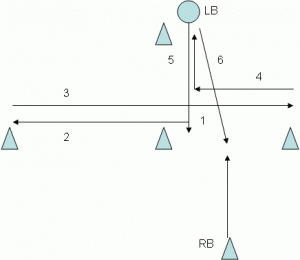
Linebacker T Drill
Purpose
- This Linebacker T Drill works on conditioning and several skills that LBs must use at any given point in the game.
- This drill helps to work on proper techniques and putting it all together. It
will also help LBs practice changing direction quickly. This does not
need to be a full-pads drill, but can be.
Description
- The linebacker will start at the base of the T of cones. The cones
should all be spread about five yards apart from each other as shown.
The linebacker will sprint up to the middle cone and catch a medicine
ball at knee level. He must sink his hips and have arms out as if
taking on a cut block. You can also have a coach or an assisting player hold a bag out
towards the LB and have the LB tap the bag down when he reaches the cone simulating the same movement. - LB sprints to the next cone. Depending on what you want to teach,
you can have him sprint directly to the cone with his shoulders
perpendicular to the line of cones, or keep the shoulders square and
crossover run as he would chasing a RB down the line. Touch the cone. - Sprint toward the far cone. A coach or player should throw a ball to
him so that he can practice moving forward and catching at the same
time. Linebacker drops the ball when he reaches the final cone. - LB then sprints back toward the middle cone.
- Run back as the linebacker would in dropping into pass coverage to
the back cone where he started. - Plant at the back cone and burst forward meeting a RB for a nice
form tackle.
Coaching Points
- Sharp Cuts, keep the feet out of cement!
- Head up and eyes forward at all times.
- Catch the ball with proper technique.
- Stay low when moving through the “T”.
Never stand straight up. - Make a good form tackle.
Shoot the arms, grab cloth, keep the feet moving and hips low.
Equipment
- Cones
- Footballs
- Eventually a bag
This Drill is contributed by ©2008 Greg Mitchell, at the time Assitant Coach/Outside Linebackers at Urbana University, OH. The Urbana Blue Knights play in the MSFA (Mid-States Football Association, NAIA)
